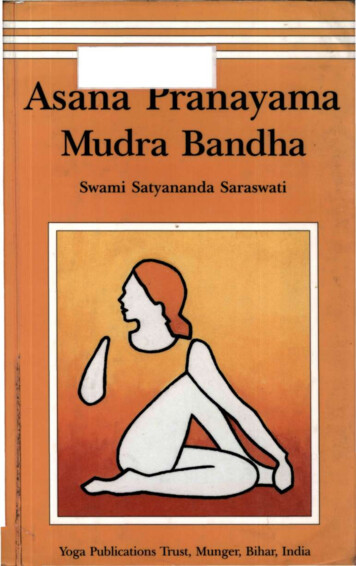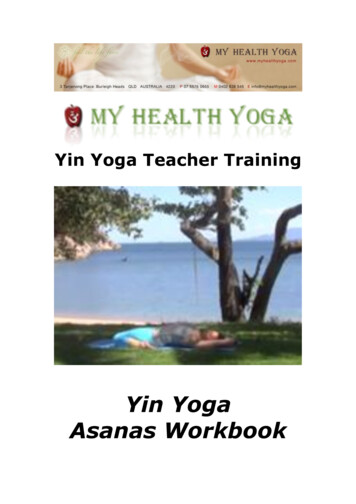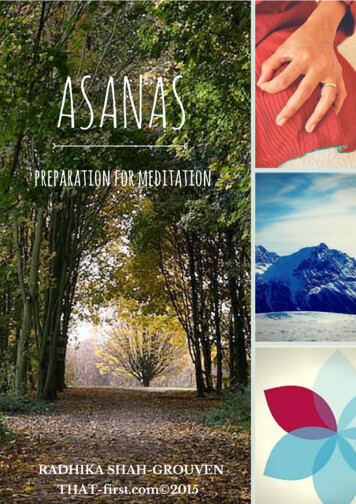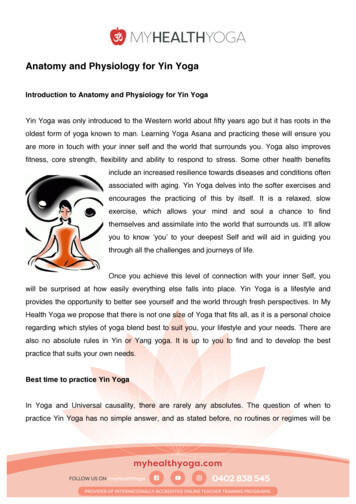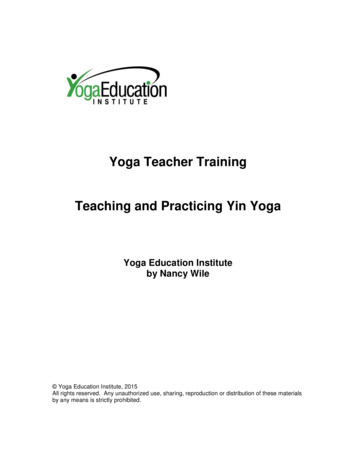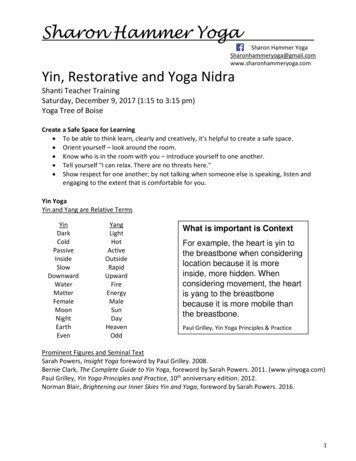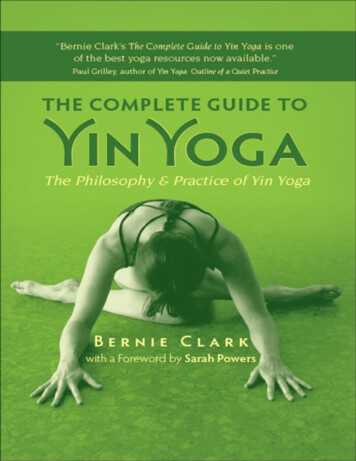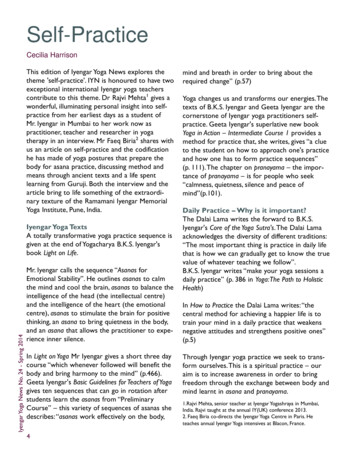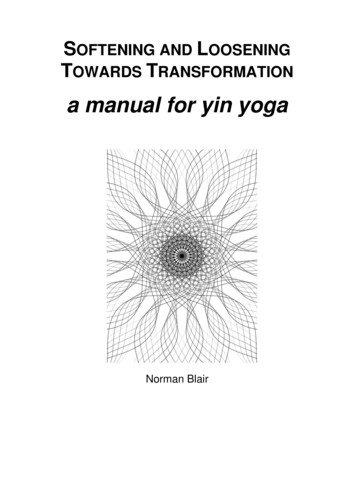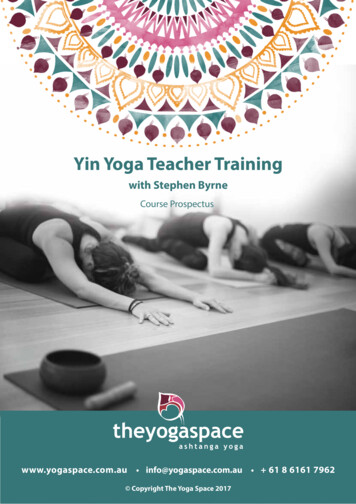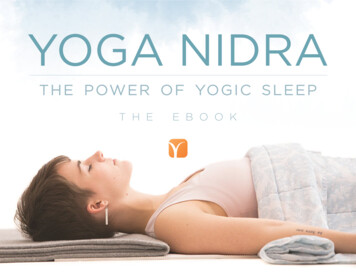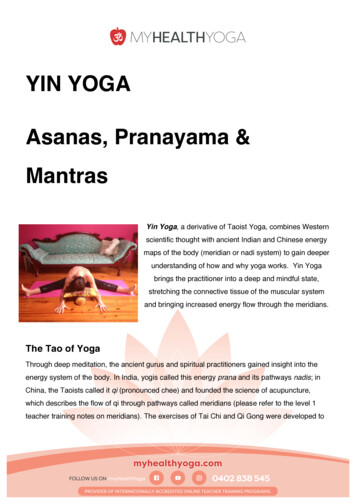
Transcription
YIN YOGAAsanas, Pranayama &MantrasYin Yoga, a derivative of Taoist Yoga, combines Westernscientific thought with ancient Indian and Chinese energymaps of the body (meridian or nadi system) to gain deeperunderstanding of how and why yoga works. Yin Yogabrings the practitioner into a deep and mindful state,stretching the connective tissue of the muscular systemand bringing increased energy flow through the meridians.The Tao of YogaThrough deep meditation, the ancient gurus and spiritual practitioners gained insight into theenergy system of the body. In India, yogis called this energy prana and its pathways nadis; inChina, the Taoists called it qi (pronounced chee) and founded the science of acupuncture,which describes the flow of qi through pathways called meridians (please refer to the level 1teacher training notes on meridians). The exercises of Tai Chi and Qi Gong were developed to
harmonize this qi flow; the Indian yogis developed their system of bodily postures to do thesame – yoga.Through the study of meridians, we know that Yin is the stable, passive, unmoving, inwardmotion of things; yang is the changing, moving, revealing, outward motion aspect. Other yinyang polarities include cold-hot, down-up, calm-excited, sun-moon, feminine-masculine, nightday.“Analyzing various yoga techniques from the perspective of yin and yang, the mostrelevant aspect is the elasticity of the tissues involved. Yang tissues like muscles aremore fluid-filled, soft, and elastic; yin tissues like connective tissue (ligaments, tendons,and fascia) and bones are drier, harder, and stiffer. By extension, exercise that focuseson muscle tissue is yang; exercise that focuses on connective tissue is yin.” (PaulGrilley)There is a movement in Western forms of yoga towards a more ‘yang’ practice such a Vinyasa,Power, and Ashtanga yoga. These styles of yoga infuse the muscles with blood, as do standingposes, Sun Salutations, or inversions. Once the muscles fill with blood, they become mucheasier to stretch. Yang-style yoga is wonderful for detoxing the body and emotions,conditioning the cardiovascular system and strengthening the muscles and mind. It could bedebated that deep flexibility and stillness of mind, however, is generally not achieved throughyang-style asanas to the degree to which yin yoga practice can. The Yin-style yoga of holdingposes for at least 3-5 minutes brings greater flexibility to the body through the release of theconnective tissue. Yin poses also develop the ability to meditate within the asana, giving rise toa greater ability to sit for longer periods of time in seated meditation (one of the ultimate goals ofasana practice).The Joint Stretch“Why would Yin Yoga advocate stretching connective tissue? We must remember thatconnective tissue is different from muscle and needs to be exercised differently. Insteadof the rhythmic contraction and release that best stretches muscle, connective tissueYIN YOGA TEACHER TRAINING ASANA PRANAYAMA & MANTRAS MODULE PAGE 2 OF 19
responds best to a slow, steady load. If you gently stretch connective tissue by holding ayin pose for a long time, the body will respond by making them a little longer andstronger—which is exactly what you want. “ (Paul Grilley)Yin tissues that we are targeting are the denser, deeper, less elastic tissues, such as theligaments, joint capsules, cartilage, bones, and fascial networks of the body. Whilst connectivetissue is found in every bone, muscle, and organ, for Yin yoga we are most concerned morewith the connective tissue in the joints. If you don't use your full range of joint flexibility, theconnective tissue will slowly shorten to the minimum length needed for your everyday activities.Prolonged shortening of connective tissue will bring rigidity and inflexibility into the joints,minimizing physical activity, and making the body more susceptible to injury. We mustremember when practicing Yin yoga that we need to completely relax our muscles to allow theprana to fully penetrate the connective tissue. This may be counter-intuitive for some peoplewho associate yoga with a ‘workout’ and feel there has to be some kind of strain felt within themuslces. Yin yoga reminds us to soften not just the muscular system of the body but also ourattitude, so we may learn that ‘less is more’.The Yin Yoga AsanasWe can assign any creative name to our Yin yoga asanas. There’s no right or wrong and likeany standard yoga pose, there are variations of the pose names from school to school. Theidea is to take traditional Hatha yoga seated postures (no standing poses in yin yoga as it is notcomfortable to hold for long periods of time) and adapt them. Each student will look differentwithin the pose based on their intuitive and healing needs. Props are often essential to bringdeep comfortability, yet are not mandatory. Yin Yoga is a cooling practice and as such, only alight warm-up of a few sun salutes is needed. Be sure to have blankets on hand for students asthe body cools within the asana. Cooling is a natural response when a person experiences ahealing release. Shivering is actually encouraged as it creates a release of tension – this is thenervous system’s primary reflex to unlock subconscious blocks in the body/mind. The pranaliterally shakes through the blocks, releasing what no longer serves our higher good. Thisphenomenon also happens within yang style yoga practice and an unaware teacher orYIN YOGA TEACHER TRAINING ASANA PRANAYAMA & MANTRAS MODULE PAGE 3 OF 19
practitioner may seek to control these involuntary movements, incorrectly believing they arefatigued. The shaking or pulsing must be encouraged for deep cellular healing. It is notuncommon for an orgasmic feeling to be experienced if the shaking is allowed to continue as allnadis (meridians) and chakras will ultimately explode with light and prana (specifically Shaktienergy – the feminine principle).It is important in Yin yoga stretches to be very physically comfortable. Observe your facialexpressions – the face needs to be relaxed – any tightening of the face is a sign to ease off.Proceed cautiously, gradually extending the depth of poses and the length of time you spend inthem (very gentle poses can be held up to 20 minutes, however, we may term this ‘RestorativeYoga’).The Three Tattvas of Yin Yoga PracticeA tattva is the reality of a thing, or its category or principal nature. Sarah Powers offers us threevery simple and very effective principles for the yin practice.1. Come into the pose to an appropriate depth ;2. Resolve to remain still ;3. Hold the pose for time.To give a deeper understanding of the Three Tattvas on Yin Yoga Practice, we can expand oneach point:1. Bring your student into the pose to their full extension initially so they are aware of wherethe point of resistance is within the pose. If we were to hold the asana at full extensionfor five minutes, we would injure ourselves – therefore, ask your student to ease backfrom the full extension to a place where they are simultaneously comfortable but stillfeeling energy (prana) in their meridians (i.e. still feeling a gentle release). Yin Yogaencourages the practitioner to find their own natural, organic shape within the pose. Ifyour intuition wants you to turn your head to the side; bend your knee/elbow; round yourYIN YOGA TEACHER TRAINING ASANA PRANAYAMA & MANTRAS MODULE PAGE 4 OF 19
spine etc, you must do so. The body has it’s own divine intelligence and will move to aplace within the pose that will conduct the best throughput of energy, providing thehighest form of healing. Each body is different and if there has been repetitive movementand injury within the body, it may be appropriate to find a shape within the body that best‘unravels’ the blockage. This can be counter-intuitive to the strict alignment techniqueswithin other styles of yoga and can challenge many experienced ‘yang’ style yogapractitioners. Be prepared to break all the rules and listen to the inner guidance!2. If you cannot remain still within the pose, you need to keep modifying the asana until youcan. Meditation is the goal here. Small movement is allowed to deepen into a pose asthe mind/body relaxes. Exploring deeper states of consciousness within, facilitated bythis powerful internal practice, can mean the body will suddenly ‘unlock’ long-heldblockages. As such, the practitioner is allowed to move to deepen the pose as feelsappropriate. Fidgeting, scratching, looking around etc is distracting and not encouraged.No darting gaze is allowed either and it is recommended that there is no dristhi; rather,the eyes are closed.3. 5 minutes is recommended in a Yin yoga pose due to the fact that it takes 2.5minutes toactivate the connective tissue; hence the remaining 2.5minutes is where the release andhealing occurs. If you the Yin pose is fairly dynamic, a 3 or 4 minute hold is suitable.Ensure that if the pose requires left and right sides of the body, the time is held equallyon both sides of the body.The Flow of Qi“Even if you only spend a few minutes a couple times a week practicing several of theseposes, you'll be pleasantly surprised at how different you feel when you sit to meditate.But that improved ease may not be the only or even the most important benefit of YinYoga. If Hiroshi Motoyama and other researchers are right—if the network of connectivetissue does correspond with the meridians of acupuncture and the nadis of yoga—strengthening and stretching connective tissue may be critical for your long-term health.YIN YOGA TEACHER TRAINING ASANA PRANAYAMA & MANTRAS MODULE PAGE 5 OF 19
Chinese medical practitioners and yogis have insisted that blocks to the flow of vitalenergy throughout our body eventually manifest in physical problems that would seem,on the surface, to have nothing to do with weak knees or a stiff back. Much research isstill needed to explore the possibility that science can confirm the insights of yoga andTraditional Chinese Medicine. But if yoga postures really do help us reach down into thebody and gently stimulate the flow of qi and prana through the connective tissue, YinYoga serves as a unique tool for helping you get the greatest possible benefit from yogapractice.” (Paul Grilley)PranayamaMaharaja Pranayama is the most appropriate breathwork technique to use in a Yin yoga pose.Also known as the ‘Royal Breath’, Maharaja Pranayama involves 3-part nostril breathing on theinhalation and 3-part breathing on the exhalation. Whilst there is no pause between the 3 parts,or chambers, of the torso, there is a definite order to fill the lower belly, then ribcage, then cheston the inhalation and a reversal of the 3 chambers on the exhalation. There is also a strongfocus on creating an even-ness of breath so that the rhythm of the in-breath is even to therhythm of the out-breath. For beginners, it may be useful to count on the inhalation and matchthe exhalation with the same count – eg. Inhale, 1, 2, 3, 4, 5; Exhale 1, 2, 3, 4, 5 (or whatevercount matches the length of breath).3-Part BreathingYogis use 3-part breathing (Maharaja Pranayama) in every yoga practice with the intention touse 3-part breathing in every moment of life. There is a traditional belief that we are onlyassigned a certain number of breaths per lifetime and we will have longevity if we learn to slowdown our breathing. People who run around busy all the time will weaken their energy and theirheart and are likely to either have illness or shorten their life expectancy.The nature of our breath tells many stories. If our inhale is longer than our exhale, we becomeover-excited and jittery as we increase adrenaline production. Many people believe this soundsYIN YOGA TEACHER TRAINING ASANA PRANAYAMA & MANTRAS MODULE PAGE 6 OF 19
appealing, yet we cannot sustain this space; ultimately it will lead to anxiety and panic attacksas well as adrenal fatigue. If our exhale is longer than our inhale we become depressed and feelthe world is a dark place. Be mindful of people when you ask, 'How are you?' and they sigh firstbefore answering: "(long sigh).I'm ok". You know they're not ok. Long, slow, deep, EVENbreaths are the key to mental and emotional stability, giving rise to Higher Connection,creativity, health, wellbeing and joyous contentment. It's a place of feeling comfort in both thefullness of the in-breath and the emptiness of the out-breath. When observed acutely, the pauseand interchange between each breath can lead to ecstasy. Your Universal Self exists in thisspace - a place without the usual unbalanced controlling, “if only ”, “what if ” mind chatter.Enter into heightened awareness of that delicious throbbing pulsation that is your Pure Divinity.How to do 3-part breathing:Sit up straight or lay on your back. When doing a healing session, talk your client through thesesteps and repeat until you can see the rise and fall of the breath from lower belly to collarbonesand back down again.InhalingAir is inhaled through the nose – the lower belly blossoms open, drawing thebreath into the ribs. The ribs expand upwards and sideways, drawing the breathto the chest. The chest fills to the collarbones. It is said we have three chambersin the torso to fill as we inhale.ExhalingAir is exhaled through the nose – decreasing the volume of the chest – the lungscontract, squeezing out stale air and physical/emotional toxins, the rib cageinwards and down and the lower belly naturally empties (the navel automaticallydraws towards the spine without effort). Remember to empty all three chamberson the exhalation.To get the most out of the breathing exercises, good respiration begins with a slow, longexhalation and the lungs should not completely empty during exhalation, nor do they fillcompletely during inhalation. About 10% of stale air stays in to keep the lungs inflated. It isimportant to practice natural breathing every day until effective breathing has become natural.YIN YOGA TEACHER TRAINING ASANA PRANAYAMA & MANTRAS MODULE PAGE 7 OF 19
Testing your BreathingYou can either sit in a chair or lay down on the floor. Lie on your back and place each hand lightly on the lower belly, parallel with the bottom ribs,fingertips touching. Become mindful of your body. Breathe in slowly, deeply and silently. Feel the lower belly move outward and notice yourhands also moving outward, fingertips moving apart, as the belly expands. Breathe out slowly, smoothly, and silently. Concentrate on the feeling in the lower belly.Notice the lower belly contracting and fingertips touching again. Move one of your hands to rest lightly on your chest, breathe. Concentrate on detecting anydifferences in the movements of your chest. Repeat steps 1-3, squeezing the lower belly on out-breaths and releasing on in-breaths, forup to five minutes. Relax for a few minutes before getting up.Slow breathingA truly wonderful phenomenon occurs when we hold our Yin poses for 3-5 minutes. Wesurrender to a deeper internal state, reaching an alpha and ultimately a theta brainwave. Wegenerally function in beta brainwave in our normal everyday reality – planning, problem-solving,analysing, making ‘to-do’ lists, regretting the past and creating anxiety for the future. With yogabreath work, we can immediately enter a reduction of the mental oscillations, reaching alphabrainwave. This creates a feeling of internal space, as we literally slow down the number ofthoughts we have. Our organs can repair more easily in this state. When we become mastersof slowing our breathing even further, we can enter theta brainwave, also known as God orUniversal Consciousness. In this space all things become known and possible. In this space,miraculous healing can occur. We can also manifest easily through prayer, plus we receivedivine inspiration through revelation (opposite to analysis, where revelation is a spontaneousknowing rather than a logical deduction). In this space, we can talk to spirit guides, angels,YIN YOGA TEACHER TRAINING ASANA PRANAYAMA & MANTRAS MODULE PAGE 8 OF 19
loved ones who have crossed over, pets who have crossed over and ascended masters.Messages come through hearing, internal seeing, knowing and feeling – all aspects of intuition.Yin Yoga is a perfect opportunity to enter alpha and theta brainwaves and creates inspiredmotivation to practice regularly. When you have the experience of ‘being breathed’, you haveentered theta brainwave. Often when this first occurs, we immediately start thinking again, in anattempt to label this deep peaceful bliss we are experiencing. Of course, this rapidly takes usout of the theta brainwave. When we practice regularly, we become comfortable in a state ofnon-thinking or non-mind and can rejuvenate deeply in these long held meditative states.KriyasYin Yoga is exceptional to bring stored physical and emotional blockages to the surface. Whenwe feel a pain or perhaps a feeling of anger or despair come to the conscious level, we need toincorporate a cleansing breath (kriya). We take 3 full inhalations through the nose and 3exhalations out of the mouth. Each exhalation gradually builds strength and the final exhalationis a elongated sigh accompanied by making an audible sound that may reflect the feeling.There are also specific sounds for the meridians that can further release tensions or anguish(please refer to our Yin Yoga Meridians module for more information).Alternate Nostril Breathing – Nadi ShodhanaYin Yoga is gentle and if we are to use a specific pranayama technique, Alternate NostrilBreathing (Nadi Shodhana) would be a wonderful soothing accompaniment to our Yin practice.Nadi Shodhana is best performed either at the beginning or end of the class to open the nadis(meridians) and assist the rising of Kundalini energy. It is also a perfect technique to incorporatejust before Savasana or final seated meditation.YIN YOGA TEACHER TRAINING ASANA PRANAYAMA & MANTRAS MODULE PAGE 9 OF 19
Nadi Shodhana brings prana to the sushumna orcentral meridian (the energy line of the spine). Aswe know, the spinal column is the central lifeline ofthe physical body and also of the spiritual body(known as the ‘sushumna’ or the body’s greatriver).Spiralling around the sushumna are two nerve channels known as Ida (activated by left nostrilbreathing) and Pingala (activated by right nostril breathing). With nadi shodhana, we stimulateIda and Pingala channels, therefore creating pranic flow to the sushumna (spinal column).Prana interweaves both the physical and the astral at the same time. In subtle body terms, thesushumna nadi is the path to enlightenment. Physically, alternate nostril breathing enlivens thespine, whilst metaphysically, kundalini (potential spiritual energy, symbolised by the cosmic orrainbow serpent) rises and opens the chakras, starting from the base of the spine; it rises upfrom its origin at the muladhara (base) chakra to its true home at the sahasrara (thousand-fold)chakra at the crown of the head (see our Yin Yoga Philosophy & Chakras module for moreinformation).The ida and pingala nadis spiral around the sushumna nadi like the double helix of our DNA,crossing each other at every chakra. If you visualise the Caduceus, the Western medicalsymbol, it shows the ultimate picture of healing, the rising of the ida, pingala, and sushumnapathways. The ida nadi begins and ends on the left side of sushumna. Ida is regarded as thefeminine or moon nadi. Please write down a description of feminine energy:YIN YOGA TEACHER TRAINING ASANA PRANAYAMA & MANTRAS MODULE PAGE 10 OF 19
Pingala, represents masculine or sun energy nadi, begins and ends to the right of sushumna.Please write down a description of masculine energy:In your opinion, why is it so important for physical, emotional, mental and spiritual health to keepan equal balance between our feminine and masculine nature:Yoga creates EquilibriumIn order to truly experience enlightenment, we must have a balance between our feminine andmasculine internal forces (which will be displayed in our outer reality). Even the term ‘Hatha’speaks of this vital balance; ‘Ha’, meaning sun or solar, and ‘tha’, meaning moon or lunar. Yogapoints repeatedly towards this balance, for without it as we are shown by Ida and Pingala nadis,we are unable to reach our highest potential as energy will stagnate in the lower spine. Weneed to move (Shakti) the energy through the sushumna in equal balance to experience bliss(Ananda).The most powerful method of balancing Ida and Pingala is Nadi Shodhana (Sanskrit for "nadi ormeridian cleansing"). A few rounds of this classical pranayama technique at the end of anasana practice restores equilibrium between the two nadis and compensates for any imbalanceyou may have inadvertently caused during your daily life.To employ alternate nostril breathing or nadi shodhana, adopt Vishnu Mudra or the index andmiddle fingers of the right hand on the third eye center.YIN YOGA TEACHER TRAINING ASANA PRANAYAMA & MANTRAS MODULE PAGE 11 OF 19
The following sequence outlines the steps to alternate nostril breathing:1. Place the index and middle fingers of the right hand on the third eye centre;2. Place the thumb beside the right nostril and the ring and little fingers beside the left nostril;3. Breathe in through the left nostril for five counts, closing the right nostril with your thumb;4. Close the left nostril;5. Breathe out through the right nostril for five counts, keeping the left nostril closed with ringand little fingers;6. Breathe in through the right nostril for five counts, keeping the left nostril closed;7. Breathe out through the left nostril for five counts, keeping the right nostril closed.The above sequence is one round. Try to do at least three rounds, building up to twenty. NadiShodhana is best done before meditation, however, for a yin yoga class it is a lovely practice tocommence a class, ensuring the rise and balance of feminine energy.Retention of Breath (Kumbhaka – meaning pot; retaining of breath in the pot of the belly)When guiding students who have been attending your yin yoga classes for a few months, thebreath can be retained after the inhalation in nadi shodhana. If inhaling and exhaling for fivecounts, the breath should be retained for five counts. Retention of breath on the inhale is called‘antara kumbhaka’.Tri-bandha (mula, uddiyana and jalandhara bandhas) is employed onantara kumbhaka whilst the internal dristhi goes to the third eye chakra. Retention of breath onthe exhale (bahya kumbhaka) is only for advanced students, and should be done under theguidance of a teacher.Mantras for TranformationMantras are united as powerful forces in relation to healing, clearing and transcending oldenergy, and ultimately transforming into wholeness and balance. A mantra is an affirmation or apositive and concise statement that draws higher energy into the present moment. Mantras aremost powerful when articulated internally (or said aloud or written down), commencing with “IYIN YOGA TEACHER TRAINING ASANA PRANAYAMA & MANTRAS MODULE PAGE 12 OF 19
am.” “I.” or “I have.” not “I am going to.”. “I am going to.” is referring to a future event.Mantras are most effective when harnessing Universal energy into the ‘now’ for manifestation.Mantras for MeridiansMeridianStomachRelated nDigestionDigesting new ideas, new belief“I digest newsystems. Eg. Accepting thatideas and waysperhaps veganism/vegetarianismwith ease.”is a better way to live for themajority of the time. This couldbe in stark contrast to how youwere raised.SpleenTransforms &Obsession and worry. Going“I am relaxed intransports bloodover and over an event whethermy thoughtsand fluids in theit be for the future or somethingand trust inbodythat has passed. Fixated onlife.”outcomes or what ‘should havebeen’. Attached to a certainperson (e.g. love interest) to thedetriment of oneself.HeartCirculation ofBlood is red and represents“I love andbloodLove. If we are not circulatingaccept ALL ofefficeintly in self-love, we can bemyself.”obsessing over others andYIN YOGA TEACHER TRAINING ASANA PRANAYAMA & MANTRAS MODULE PAGE 13 OF 19
external events in order to feel okand in control (spleen meridiandysfunction). Heart meridianhealing, therefore, is about lovingoneself unconditionally andresting in the knowing that youare enough.Each meridian has a corresponding feeling or emotion. When we understand the metaphysicalaspects of each meridian, deeper healing can occur. Often at the times emotions come to thesurface, we are unsure how to release them. Observing an emotion with the ‘Light of yourAwareness’ without resistance provides a tremendous ability to transcend (rise above) theemotion. It is in a sense ‘half way there’ in terms of healing. Often we need to release theemotion to complete the healing cycle. If we continue to bury emotions and don’t allow them tomove (E-Motions: Energy in Motion) they will become buried again in our consciousness andcreate a pain body both emotionally and physically, which will result in the same unwantedpatterns being carried out in our lives. Repeating a mantra by allowing it to reverberate in themind over and over can create a change in the mind’s habitual neural pathway (like a loop ofsame repetitive thinking and belief systems). In a sense we create an ‘exit ramp’ from themental loop for a new thinking/belief to be created. The meridians energetically speak to usabout our emotions which are like archetypal energies common to all human beings. When wecan identify the physical and metaphysical function on the meridian, we can then create ahealing mantra for transformation.YIN YOGA TEACHER TRAINING ASANA PRANAYAMA & MANTRAS MODULE PAGE 14 OF 19
Small IntestineAbsorbs nutrientsThe ‘small’ intestine takes care“I care for theand assists inof the finer details of digestionsmall details indigestion &and elimination, and as suchmy lifeelminationmetaphysically reminds us toeffortlessly.”look after the smaller details ofour lives. When we care for thesmall aspects of life, the largerprojects will be achievedeffortlessly. Cleaning out yourcupboards and doing all theseemingly inconsequential,menial tasks at home and atwork clear the energy for yourbig dreams to manifest.BladderStores andThe bladder is a ‘letting go’“I let go of myeliminates urineorgan, so our soul lessons relatepast with lovingto acceptance of what is/hasacceptance.”been and the ability to surrenderwith trust that events need to beas they have been for ourhighest good/growth.KidneyFilters blood andIf you are ‘pissed off’ at life or“I acceptadd water to urinesomeone for extended periods ofothers’for releasetime the kidneys can be affected.differences andBitter emotions are toxic and canflow peacefullyphysically add a toxic load tothrough life.”your urine. The water element iskey here – pure thoughts, pureYIN YOGA TEACHER TRAINING ASANA PRANAYAMA & MANTRAS MODULE PAGE 15 OF 19
water, clean urine – it’s all aboutthe flow.PericardiumMuscle wallThe pericardum can energetically“I open thesurrounding theopen or close, allowing love in orgateway to myheart (protects the‘walling’ off the experience ofheart and feelheart)love. Many people need to opencomfortable inthe pericardium and allow themyheart to be vulnerable to beingvulnerability”;loved and possibly hurt in thealso “I protectprocess. To not open to lovemy personalcripples the soul. The other sideenergy.”is there are people whoconstantly ‘give their heart away’and need to learn how to protecttheir heart (protection is differentto closing off the heartaltogether).YIN YOGA TEACHER TRAINING ASANA PRANAYAMA & MANTRAS MODULE PAGE 16 OF 19
TripleWarmer/Burner3 'burners',Triple-warmer or Triple-burnerlocated in thorax,energy involves our ability to takeabdomen, andin life’s experiences withoutpelvis. The Upperresistance, to process ourBurner controlsemotions related to theseour intake, theexperiences with a sense of joyMiddle Burnerand to let go of any stuck, hurtfulgovernsor resentful emotions. A perfecttransformation, thebalance is required to live aLower Burnerharmonious life.“I am balanced.supportseliminationGall-bladderStores andGall-bladder and Liver work in“I purge whatexcretes biletandem to process and releaseno longer(strongtoxins. Dark, angry thoughts canserves myrelationship withget clogged in our system,higher goodthe liver)leading to violence in our wordswith calmness.”and actions. We need to acceptthat we have to find a way toheal our pain and not usedestructive force to control life.LiverThe liver filtersProcessing our feelings and“I processand processesunderstanding that withoutexperiencesblood,challenges we could not growand emotionsmetabolisesspiritually gives us gratitude forwith peace andnutrients, andall life’s experiences andgratitude.”detoxifies harmfuleliminates anger and resistancesubstancesfrom our life.YIN YOGA TEACHER TRAINING ASANA PRANAYAMA & MANTRAS MODULE PAGE 17 OF 19
LungTakes in breathLungs metaphysically govern our“Knowing I amand life-forceworthiness to breathe in theworthy, Ienergy (prana) –magnifience of life.breathe in life’swithout this wegoodness.”would die quicklyLarge Intestine:Elimination of solidHolding on to old ways can keep“I trust inwastesour souls stuck in patterns whereelimination towe may feel safe, yet are failingstay in harmonyto grow in consciousness.with life’sLeaving our job, parnter, home-cycles.”town, country etc can sometimesbe what is required to take aquantum leap in healing,transformation andconsciousnessYIN YOGA TEACHER TRAINING ASANA PRANAYAMA & MANTRAS MODULE PAGE 18 OF 19
Yin Yoga Asanas ActivityYin Yoga postures focus on releasing the major joints of the body. See if you can create yourown yin pose (or a variation of the poses listed). Write down appropriate YIN poses(comfortable to hold for 5 minutes) plus your own visualisation and mantra (affirmation) for:SHOULDER JOINT:HIP
Pranayama Maharaja Pranayama is the most appropriate breathwork technique to use in a Yin yoga pose. Also known as the ‘Royal Breath’, Maharaja Pranayama involves 3-part nostril breathing on the inhalation and 3-part breathing on the
